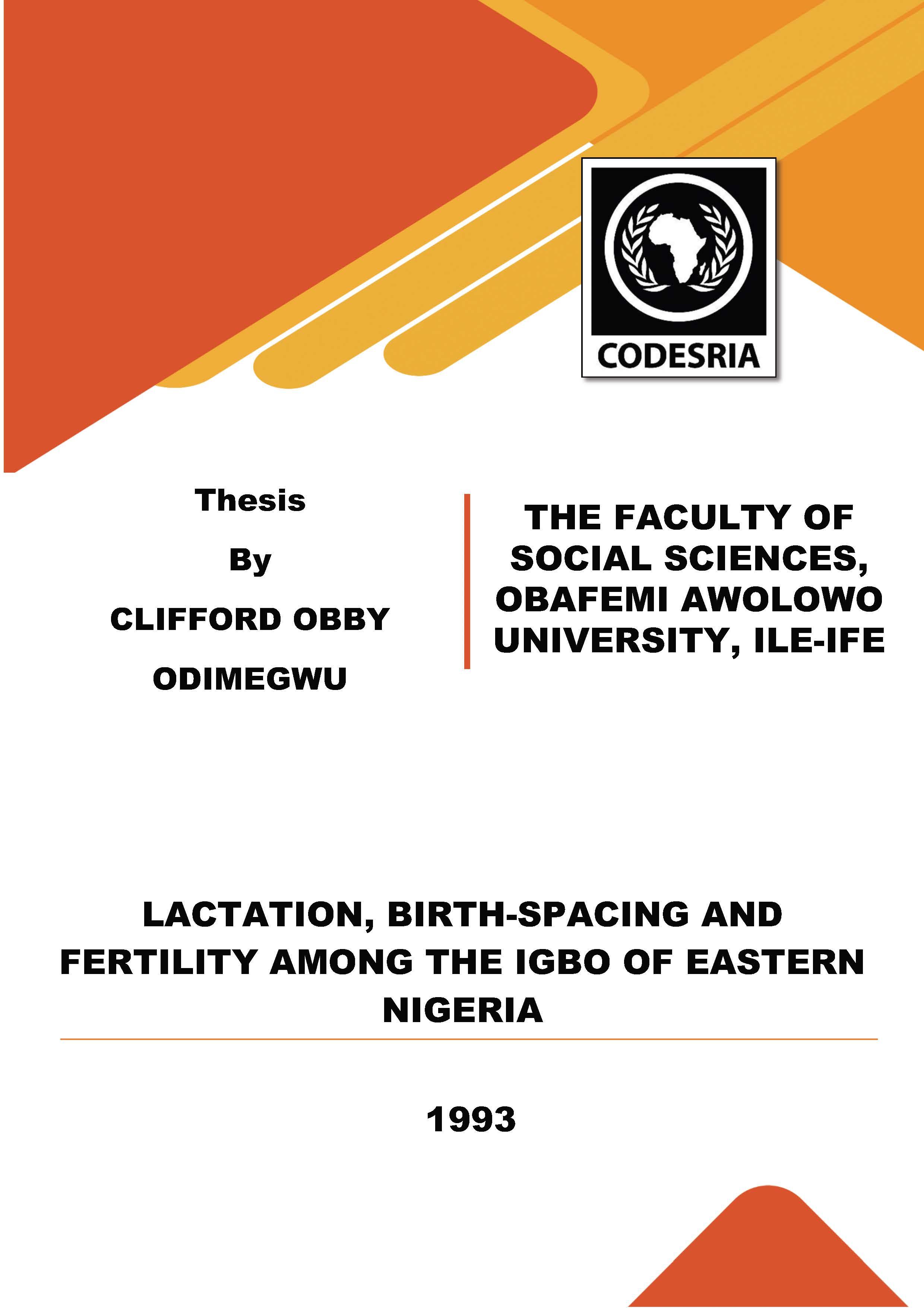LACTATION, BIRTH-SPACING AND FERTILITY AMONG THE IGBO OF EASTERN NIGERIA
Keywords:
LACTATION, BIRTH-SPACING, FERTILITY, EASTERN NIGERIASynopsis
Current interest in breast-feeding practice is a recognition of its role in population growth and child survival. The concern has been about the potential impact of reductions in the proportions of infants ever breastfed and or the duration of breast-feeding on population growth.The relationship between breast-feeding and fertility interest policy makers because a decline in
breast-feeding without a compensatory increase in contraceptive use would result in higher population growth rates. Other things being equal, infant health and maternal fertility are directly affected by the pattern of infant feeding and duration of breast-feeding.
Although these mechanisms have been known, certain aspects of the association especially the link between breast-feeding and birth-spacing have not been delineated. This study therefore examines the relationship between breast-feeding and birth-spacing, and their effect on fertility level among the Igbo of Nigeria. The study examines the main factors that affect birth-spacing dynamics in the area. It also estimates the level and proximate determinants of fertility in the area. Data for this study were collected from a four-month fieldwork in some selected areas in Imo State, Nigeria. On the whole, 819 respondents, who are women of reproductive age groups 15 - 49 were interviewed. The analysis was done using both descriptive and inferential
statistics. The proportional hazards model was the main statistical technique used. The results of the analysis are both interesting and revealing. Fertility level is still high with reported total fertility rate of 7.3, gross reproduction rate ( 3. 5) , and general fertility rate (250). Adjusted total fertility rate is 7.4, and completed family size is 6.2 for women aged 45 and above.
Family planning method use is low.
The study shows that the initiation and practice of breast-feeding is high, although there is variation among social groups. The durations of post-partum variables are as follows: breast-feeding (10.6), postpartum amenorrhea ( 6. 6) and post-partum sexual abstinence (7.4). The birth interval length is 24.8 months on the average. These variables varied considerably by some socioeconomic factors, while breast-feeding determines the direction of other post-partum variables. A proportional hazard analysis of the determinants of the birth-spacing variables of breast-feeding, amenorrhea and abstinence and birth interval confirmed our hypotheses. The result showed that breast-feeding is the principal and consistent determinant of all other
child-spacing variables. The principal and significant determinants of breast-feeding duration are parity, education, asset ownership, work status, best infant food and birth attendant perception of Education and rural-urban residence were found not to be significant when other variables are included. Using Bongaarts' model, a total fertility rate of 5. 1 per woman is estimated compared with 7.26 actually observed from the survey. The estimated total fertility rate results from the assumed total fecundity of 15. 3 births per woman being inhibited by indexes of the proximate determinants most notably index of post-partum nonsusceptibility as a result of amenorrhea and abstinence (38 %) , contraception (mainly traditional methods, 27%) and marriage (26 %). A decomposition of the post-partum non susceptibility shows that postpartum sexual abstinence inhibited 2.7 births while amenorrhea inhibited 1.~. An examination of the percent reduction accounted by each of the proximate variables shows that postpartum infecundability reduces birth by 47 percent, contraception (30%), and nonmarriage (23%). Considering the length of birth interval, our result shows that breast-feeding contributes 43 % to birth interval, abstinence (30%), amenorrhea (25%) and contraceptive use (0.4%).
However, on the basis of our findings, this study posited that changes in the duration and patterns of breast-feeding occurring in the society as a result of modernization will lead to higher fertility, unless the people of the area start practising contraception. It is therefore important to recognise the need for programmes that will encourage the initiation and continuation of breast-feeding practice while simultaneously promoting the use of appropriate contraceptive methods. The current Baby Friendly Initiative programme mounted by UNICEF and WHO has to be encouraged and intensified by the government in every hospital and maternity centres.
Downloads
References
Jelliffe, D.B. and E.F. P. Jellife (1978): Human Milk inthe Modern World , Oxford University Press,
London.
Johnson, J. (1977): "The Household context of Infant feeding practices in South Trinidad", Lactation Review 2: 412-423.
Johnson, N.E., C.S. Stokes and R.H. Wardard (1978): "Farm-nonfarm differentials in fertility: the effects of compositional and sex-role factors", Rural Sociology, 43 (4): 671-690.
Jone, E.F. (1982): "Socio-economic differentials in fertility", WFS Comparative studies, No 21; International Statistical Institute, Voorburg, The Netherlands, p. 1.
Kalbfleisch, J. and R. Prentice (1980): The statistical analysis of failure time data, Wiley Press, USA.
Kay, R. (1977): "Proportional Hazards Regression Models and the analysis of Censored Survival Data",
Applied Statistics 26: 227-237.
Kelley, A. c., A. M. Khalifa and M. Nabil El-Kher Zaty (1982): Egypt, Social Population and Development in Rural (Duke Press Policy Studies: Studies in and Economic Demography), Duke University Press, Durban.






